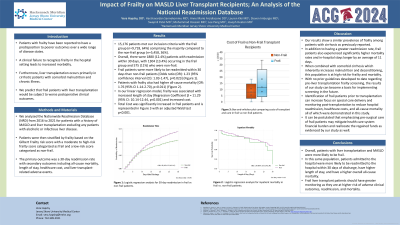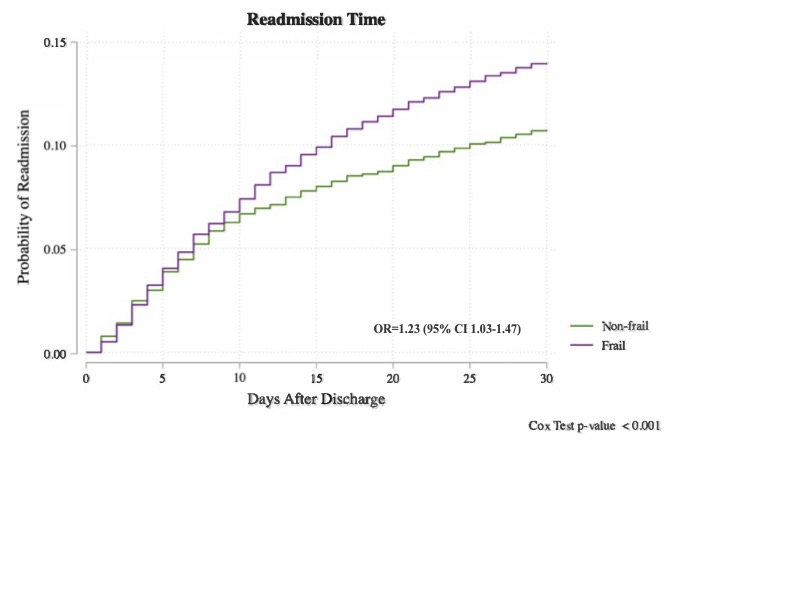Monday Poster Session
Category: Liver
P2866 - Impact of Frailty on MASLD Liver Transplant Recipients: An Analysis of the National Readmission Database
Monday, October 28, 2024
10:30 AM - 4:00 PM ET
Location: Exhibit Hall E

Has Audio

Vera Hapshy, DO
Jersey Shore University Medical Center
Marlboro, NJ
Presenting Author(s)
Vera Hapshy, DO1, Harshavardan Sannekommu, MD2, Anne Marie Arcidiacono, DO2, Lauren Klei, MD2, Steven Imburgio, MD2, Swapnil Patel, MD2, Mohammad Hossain, MD2, Lee Peng, MD, PhD3, Joseph Heaton, MD4
1Jersey Shore University Medical Center, Marlboro, NJ; 2Jersey Shore University Medical Center, Neptune, NJ; 3Jersey Shore University Medical Center, Neptune City, NJ; 4Hackensack Meridian Health, Neptune, NJ
Introduction: Patients with frailty have been reported to have a predisposition to poorer outcomes over a wide range of disease states. There is also a clinical failure to recognize frailty in the hospital setting leading to increased morbidity. Furthermore, liver transplantation occurs primarily in cirrhotic patients with comorbid malnutrition and chronic illness. We predict that frail patients with liver transplantation would be subject to worse postoperative clinical outcomes.
Methods: We analyzed the Nationwide Readmission Database (NRD) from 2016 to 2021 for patients with a history of MASLD and liver transplantation excluding any patients with alcoholic or infectious liver disease. Patients were then stratified by frailty based on the Gilbert Frailty risk score with a moderate to high-risk frailty score categorized as frail and a low-risk score categorized as non-frail. The primary outcome was a 30-day readmission rate with secondary outcomes including all-cause mortality, length of stay, healthcare cost, and liver-transplant-related adverse events.
Results: In total, 15,176 patients met our inclusion criteria with the frail group (n=9,718, 64%) comprising the majority compared to the non-frail group (n=5,458, 36%). Overall, there were 1880 (12.4%) patients with readmission within 30 days, with 1304 (13.4%) occurring in the frail group and 575 (11%) who were non-frail. Frail patients were more likely to be readmitted within 30 days than non-frail patients [Odds ratio (OR): 1.23 (95% confidence interval (CI): 1.03-1.47), p=0.023] (Figure 1). Patients with frailty also had higher mortality [OR: 1.76 (95% CI 1.14-2.70), p=0.011). In our linear regression model, frailty was associated with increased length of stay (Regression Coefficient β = 11.29 (95% CI: 10.14-12.44, p< 0.001) and increased cost.
Discussion: Overall, patients with liver transplantation and MASLD were more likely to be frail. In this same population, patients admitted to the hospital were more likely to be readmitted to the hospital within 30 days of discharge, have higher length of stay, and have a higher overall all-cause mortality. Frail liver transplant patients should have greater monitoring as they are at higher risk of adverse clinical outcomes.

Disclosures:
Vera Hapshy, DO1, Harshavardan Sannekommu, MD2, Anne Marie Arcidiacono, DO2, Lauren Klei, MD2, Steven Imburgio, MD2, Swapnil Patel, MD2, Mohammad Hossain, MD2, Lee Peng, MD, PhD3, Joseph Heaton, MD4. P2866 - Impact of Frailty on MASLD Liver Transplant Recipients: An Analysis of the National Readmission Database, ACG 2024 Annual Scientific Meeting Abstracts. Philadelphia, PA: American College of Gastroenterology.
1Jersey Shore University Medical Center, Marlboro, NJ; 2Jersey Shore University Medical Center, Neptune, NJ; 3Jersey Shore University Medical Center, Neptune City, NJ; 4Hackensack Meridian Health, Neptune, NJ
Introduction: Patients with frailty have been reported to have a predisposition to poorer outcomes over a wide range of disease states. There is also a clinical failure to recognize frailty in the hospital setting leading to increased morbidity. Furthermore, liver transplantation occurs primarily in cirrhotic patients with comorbid malnutrition and chronic illness. We predict that frail patients with liver transplantation would be subject to worse postoperative clinical outcomes.
Methods: We analyzed the Nationwide Readmission Database (NRD) from 2016 to 2021 for patients with a history of MASLD and liver transplantation excluding any patients with alcoholic or infectious liver disease. Patients were then stratified by frailty based on the Gilbert Frailty risk score with a moderate to high-risk frailty score categorized as frail and a low-risk score categorized as non-frail. The primary outcome was a 30-day readmission rate with secondary outcomes including all-cause mortality, length of stay, healthcare cost, and liver-transplant-related adverse events.
Results: In total, 15,176 patients met our inclusion criteria with the frail group (n=9,718, 64%) comprising the majority compared to the non-frail group (n=5,458, 36%). Overall, there were 1880 (12.4%) patients with readmission within 30 days, with 1304 (13.4%) occurring in the frail group and 575 (11%) who were non-frail. Frail patients were more likely to be readmitted within 30 days than non-frail patients [Odds ratio (OR): 1.23 (95% confidence interval (CI): 1.03-1.47), p=0.023] (Figure 1). Patients with frailty also had higher mortality [OR: 1.76 (95% CI 1.14-2.70), p=0.011). In our linear regression model, frailty was associated with increased length of stay (Regression Coefficient β = 11.29 (95% CI: 10.14-12.44, p< 0.001) and increased cost.
Discussion: Overall, patients with liver transplantation and MASLD were more likely to be frail. In this same population, patients admitted to the hospital were more likely to be readmitted to the hospital within 30 days of discharge, have higher length of stay, and have a higher overall all-cause mortality. Frail liver transplant patients should have greater monitoring as they are at higher risk of adverse clinical outcomes.

Figure: Logistic regression analysis for 30-day readmission in Frail vs non-frail patients
Disclosures:
Vera Hapshy indicated no relevant financial relationships.
Harshavardan Sannekommu indicated no relevant financial relationships.
Anne Marie Arcidiacono indicated no relevant financial relationships.
Lauren Klei indicated no relevant financial relationships.
Steven Imburgio indicated no relevant financial relationships.
Swapnil Patel indicated no relevant financial relationships.
Mohammad Hossain indicated no relevant financial relationships.
Lee Peng indicated no relevant financial relationships.
Joseph Heaton indicated no relevant financial relationships.
Vera Hapshy, DO1, Harshavardan Sannekommu, MD2, Anne Marie Arcidiacono, DO2, Lauren Klei, MD2, Steven Imburgio, MD2, Swapnil Patel, MD2, Mohammad Hossain, MD2, Lee Peng, MD, PhD3, Joseph Heaton, MD4. P2866 - Impact of Frailty on MASLD Liver Transplant Recipients: An Analysis of the National Readmission Database, ACG 2024 Annual Scientific Meeting Abstracts. Philadelphia, PA: American College of Gastroenterology.

